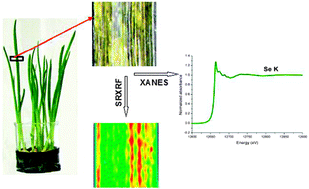Mercury modulates selenium activity via altering its accumulation and speciation in garlic (Allium sativum)†
Abstract
Combined pollution of selenium (Se) and mercury (Hg) has been known in Wanshan district (Guizhou Province, China). A better understanding of how Se and Hg interact in plants and the phytotoxicity thereof will provide clues about how to avoid or mitigate adverse effects of Se/Hg on local agriculture. In this study, the biological activity of Se has been investigated in garlic with or without Hg exposure. Se alone can promote garlic growth at low levels (<0.1 mg L−1), whereas it inhibits garlic growth at high levels (>1 mg L−1). The promotive effect of Se in garlic can be enhanced by low Hg exposure (<0.1 mg L−1). When both Se and Hg are at high levels, there is a general antagonistic effect between these two elements in terms of phytotoxicity.

- This article is part of the themed collection: Metallomics in China

 Please wait while we load your content...
Please wait while we load your content...